Sculpt your arms while rebounding by using the bounce-and-lift technique with light dumbbells for overhead presses and curls. Add resistance bands for targeted definition through kickbacks and lateral raises. Incorporate dynamic arm movements like punches and circles synchronized with your bounce rhythm. Try progressive arm circuits to gradually increase intensity with wrist weights. Challenge your balance with single-leg poses and isometric holds for total upper body toning. Discover how these five approaches transform flabby arms into defined muscles.
Master the Bounce-and-Lift Arm Sculpting Technique
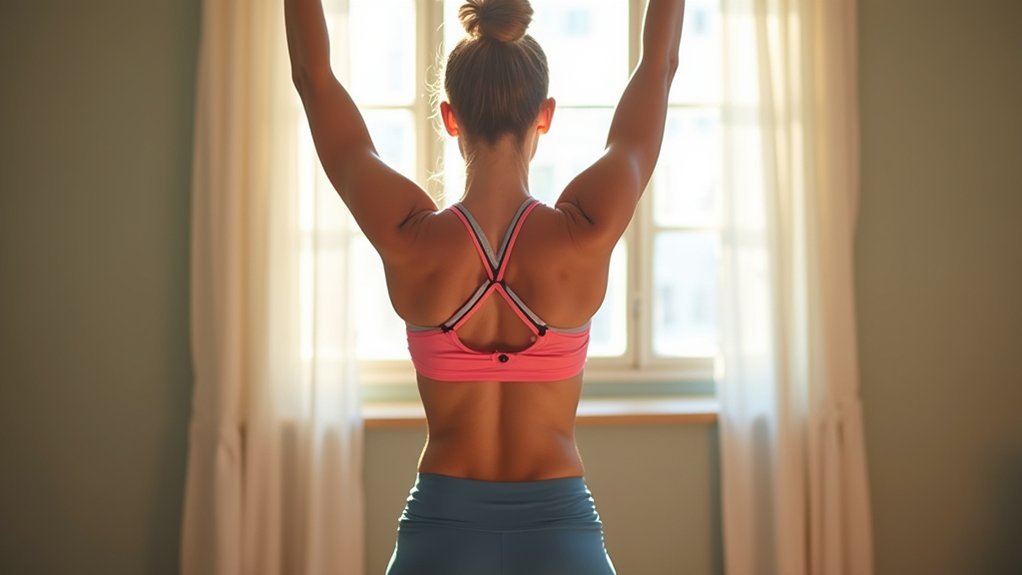
While many fitness enthusiasts focus solely on the cardiovascular benefits of rebounding, this dynamic exercise form offers an exceptional opportunity to sculpt your arms simultaneously.
The technique centers on synchronizing arm movements with your bounce rhythm. Grab light dumbbells (1-5 lbs) or water bottles and coordinate each lift with your upward bounce phase. As your feet leave the rebounder, press dumbbells overhead or perform lateral raises to maximize muscle engagement. Incorporating exercises like hammer curls will effectively target your brachioradialis and brachialis muscles, contributing to overall arm thickness.
To intensify results, add pulse variations at the peak of each movement—small up-down motions during a shoulder raise will fire up those triceps.
Take your arm workout to new heights with micro-pulses—these tiny movements create maximum burn when muscles are fully engaged.
Keep your elbows lifted during curls and presses to prevent momentum-driven swings and truly isolate the target muscles. This synchronization creates a unique resistance pattern that challenges your arms from multiple angles.
Incorporate Resistance Bands for Targeted Arm Definition
Although dumbbells provide excellent resistance for arm sculpting, resistance bands offer unique advantages when paired with rebounding workouts. They’re lightweight, portable, and provide variable resistance that intensifies as you stretch them—perfect for dynamic rebounding movements.
For maximum arm-sculpting benefits while bouncing:
- Choose looped bands or bands with hooks to perform triceps kickbacks and bicep curls simultaneously with your bounce.
- Target deltoids with overhead presses and lateral raises while maintaining balance on the rebounder.
- Perform arm circles with bands to enhance shoulder definition and coordination.
- Start with lighter resistance and proper posture to prevent injury while maximizing muscle activation.
- Combine cardio benefits of rebounding with strength training for efficient, joint-friendly workouts that improve posture.
- Alternate between one-minute intervals of cardio bouncing and resistance band strength moves to maximize total body transformation.
Dynamic Arm Movements That Maximize Rebounding Benefits
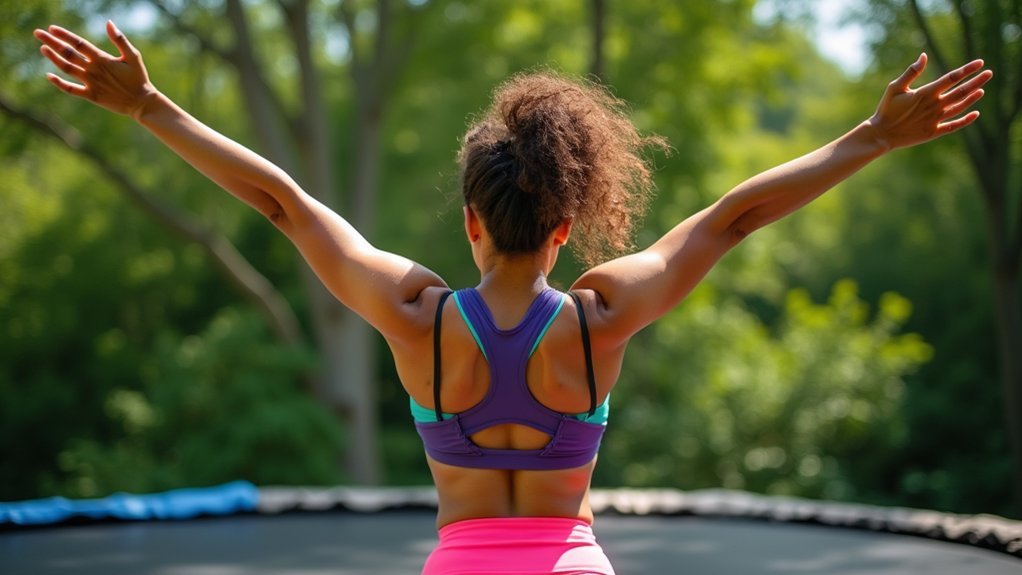
Dynamic arm movements transform a standard rebounding session into a thorough upper body workout without adding weights or bands. Incorporate alternating arm swings to coordinate with your bounce rhythm, engaging deltoids while improving shoulder mobility and posture alignment.
Try punching motions to activate biceps, triceps, and chest muscles while enhancing core stability. This boosts calorie burn and develops explosive arm strength. The natural resilience of trampolines makes these movements low-impact on joints while still delivering impressive strengthening results.
Mix in arm circles to target rotator cuff muscles and increase joint flexibility—vary between small and large circles in both directions for balanced muscle development.
For isometric training, hold your arms in T or Y positions while bouncing to create static muscle tension.
Finally, add reach-and-pull movements that mimic rowing to strengthen your upper back and improve posture while maintaining the low-impact benefits of rebounding.
Progressive Arm Circuits on Your Mini Trampoline
A progressive arm circuit transforms your rebounding routine into a sculpting session for sleek, defined arms.
Start with simple movements synchronized to your bounce rhythm, then gradually incorporate more complex patterns as your coordination improves.
The key to effective arm sculpting lies in strategic progression:
- Begin with basic arm movements at a slower pace, allowing muscles to warm up properly.
- Add circular motions in both directions to engage different muscle groups.
- Incorporate punching movements with both bent and extended arms for complete activation.
- Increase intensity by adding wrist weights (starting at 1 pound) once you’ve mastered form.
- Match your arm movement tempo to your rebounding rhythm for ideal muscle engagement.
For maximum results, integrate these circuits throughout your routine, balancing arm work with total-body movements. Consider adding jab cross movements to your sequence as they effectively engage the upper body while maintaining the benefits of rebounding.
Balance-Challenging Arm Exercises for Total Upper Body Toning
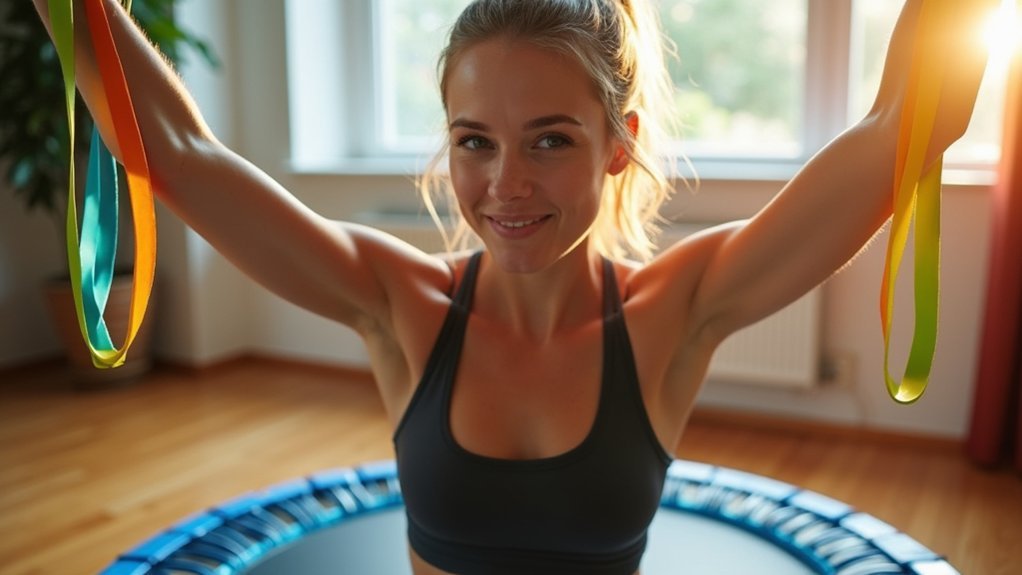
Balance-challenging arm exercises elevate your rebounding practice from simple toning to extensive upper body development. By combining dynamic instability with targeted movements, you’ll enhance coordination while engaging multiple muscle groups simultaneously. These exercises are especially beneficial as they provide a low-impact alternative to traditional strength training while still effectively targeting the arm muscles.
| Exercise | Benefit |
|---|---|
| Arm Raises with Single-Leg Balance | Improves coordination and core stability |
| Isometric Arm Holds During Bounces | Strengthens muscles without joint strain |
| Arm Circles While Jogging in Place | Enhances shoulder flexibility and circulation |
| Unilateral Plyometric Pushes | Boosts power and muscular endurance |
Keep your feet hip-width apart for stability, maintain proper knee alignment, and always engage your core to prevent joint strain. Remember to start slowly and incorporate rest periods—these low-impact yet high-intensity exercises efficiently support lymphatic drainage while sculpting leaner, stronger arms.
Frequently Asked Questions
How Long Does It Take to See Results in Arm Definition?
You’ll notice initial neural improvements in 2-4 weeks, visible tone in 1-2 months, and significant definition in 4-6 months. Consistency, protein intake, and body fat levels dramatically influence your timeline.
Can Rebounding Replace Traditional Weightlifting for Arm Strength?
No, rebounding can’t fully replace weightlifting for arm strength. While you’ll gain some muscle tone and endurance from rebounding, you won’t achieve the targeted resistance and progressive overload that weightlifting provides for maximum arm development.
Is Rebounding Effective for Reducing Arm Flab and Cellulite?
Yes, rebounding can help reduce arm flab and cellulite. You’ll burn calories overall while improving circulation. Add arm movements or light weights during your bouncing sessions for enhanced toning and cellulite-reducing benefits.
Should Seniors Modify Arm Exercises When Rebounding?
Yes, you should modify arm exercises when rebounding as a senior. Lower your arms slightly, reduce the range of motion, and move more slowly to protect your joints while still getting cardiovascular benefits.
How Does Rebounding Affect Existing Arm Muscle Imbalances?
Rebounding helps correct your arm muscle imbalances by promoting balanced engagement of both limbs. You’ll experience improved coordination, proprioception, and symmetrical muscle activation patterns while the low-impact nature supports gradual strength equalization.
In Summary
Incorporating these five arm-sculpting techniques into your rebounding routine will transform your upper body while you’re enjoying a low-impact cardio workout. You don’t need fancy equipment or hours at the gym—just your mini trampoline and consistent practice. Remember to start gradually and increase intensity as you build strength. Within weeks, you’ll notice more defined arms and improved overall stability. Keep bouncing your way to sculpted arms!

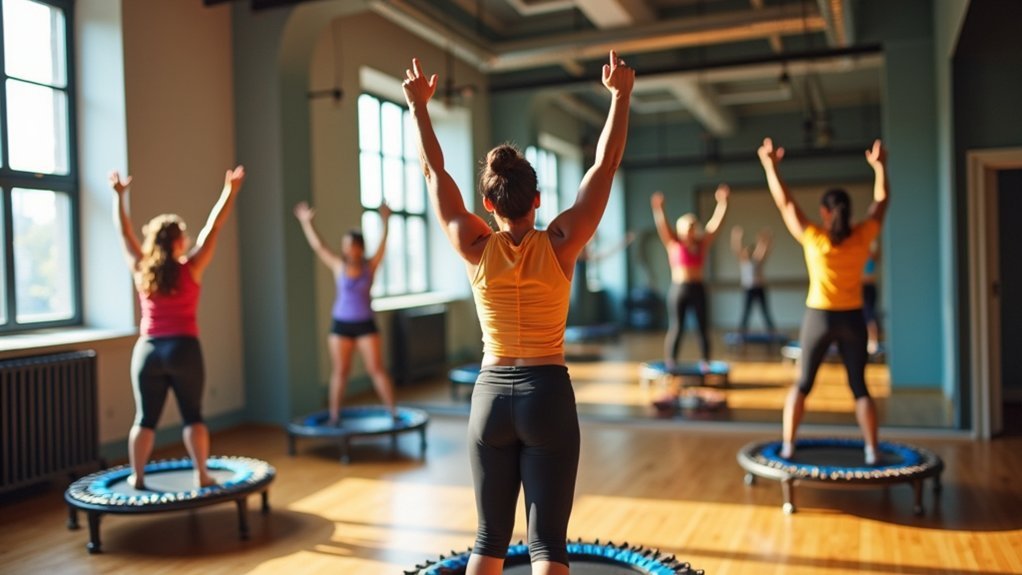
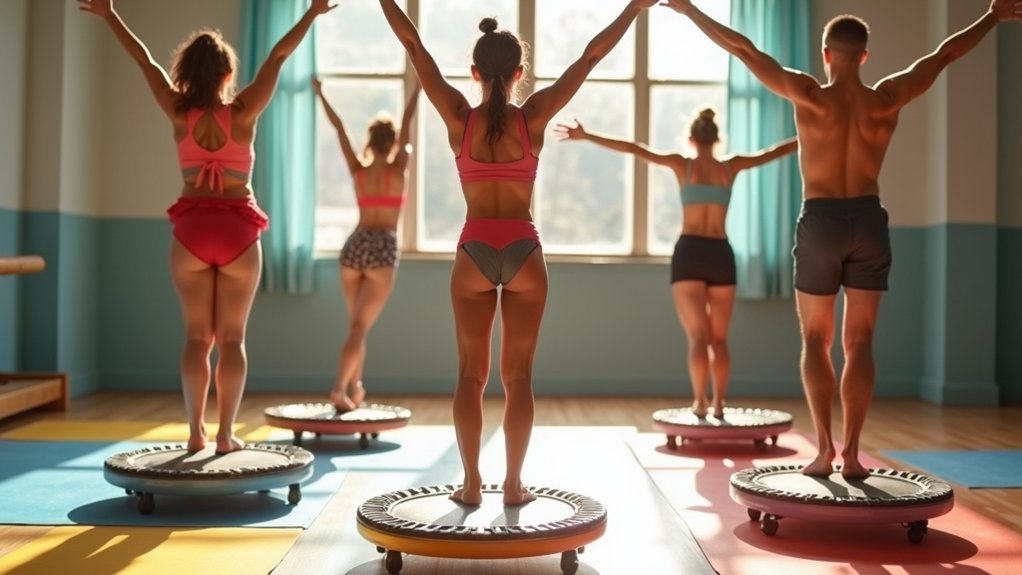
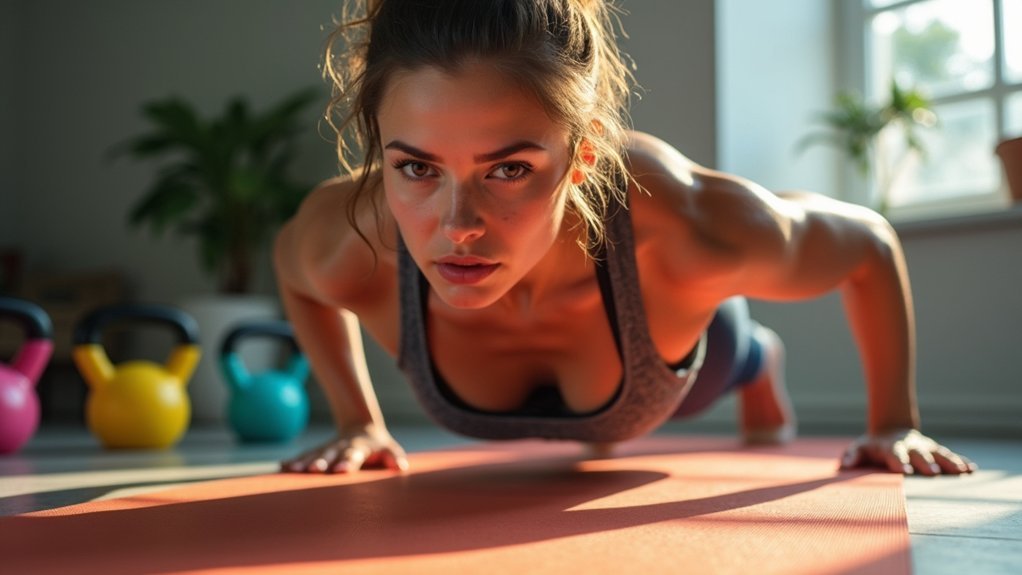

Leave a Reply